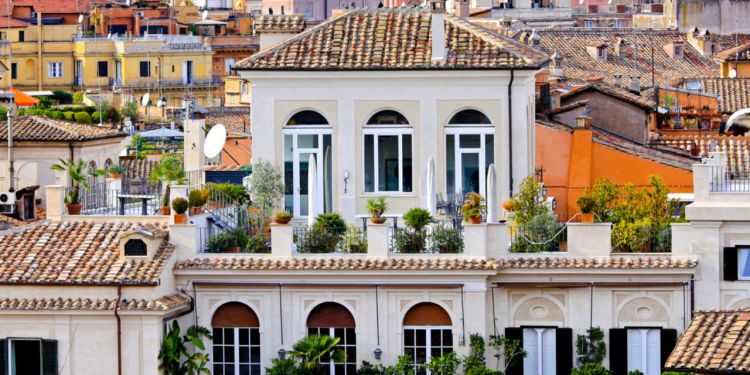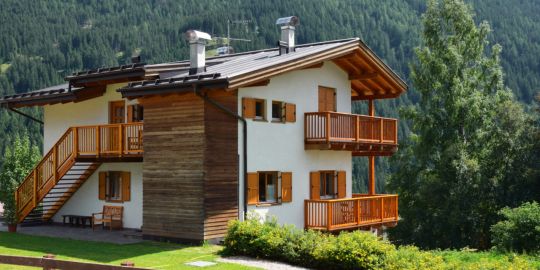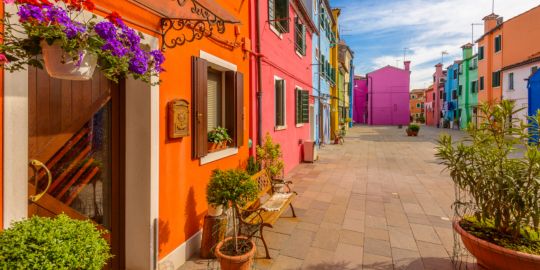Accommodation in Rome

Rome is a popular destination for expatriates. In addition to its pleasant climate, Italy's capital is full of historical monuments, art and culture. It is also home to a number of multinational companies, as well as many prestigious schools and universities, tourist attractions, restaurants, bars and hotels. It is the ideal city for expats looking to experience a whole new way of life.
For expats who are unfamiliar with the area and the language, finding accommodation in Rome can be a daunting task. Which neighborhood to choose, who to contact, what documents to provide, how much to spend, etc., are some of the questions that newcomers have to ask themselves. Where to stay in Rome (apart from a hotel, of course)? In this article, we will try to give you some advice on where to put your bags and how to start your expat life in Italy.
Types of accommodation in Rome
Rome is a big city that offers peace and quiet in places like its suburbs but also a more active lifestyle in the central areas of the city, like the centro storico. When looking for a place to live, be sure to consider transportation options, especially if you choose to rent outside the center. If you have a car or intend to buy one, be aware that parking can be a hassle, and you will need to be patient unless you rent a box, as the streets are usually full of vehicles.
As in most Italian cities, accommodation in Rome is in apartment buildings, some of which have ground floors reserved for caretakers or commercial use (restaurants, bakeries, grocery shops, etc.). Some may have balconies or small terraces and sometimes a lift. Unsurprisingly, rental prices tend to drop the further away you are from the historic center or from tourist attractions such as the Colosseum.
It is common in Rome to find rooms for rent only in a shared flat. This is often the most economical choice for someone moving to Rome alone. It is also a great way to meet people.
The different types of flats you can find in Rome are:
- Monolocale: studio apartment (from 25 - 40 m²)
- Bilocale: two-room flat (from 50 - 60 m²)
- Trilocale: three-room flat (from 80 m²)
- Quadrilocal: four-room flat (from 100 - 120 m²)
- Attico: penthouse apartment with usually large terrace
Good to know:
The Roman property market has its own habits, as in the rest of Italy. It is not uncommon to see a fully furnished (dining room furniture, beds, wardrobes, etc.) or semi-furnished flat for rent. This is known as an arredato or semi arredato flat. It is also possible that when a flat is sold, the fitted kitchen has been dismantled and recovered by the owners, including appliances such as the fridge or the dishwasher. If you wish to keep it, you will have to buy it in addition to the property for sale.
The calculation of square meters is different between the living area and commercial area, the latter also taking into account any balconies, cellars, etc. So be careful when searching for or visiting a rented flat and ask the real estate agency/landlord what the advertised square meters actually include.
The housing market in Rome
According to a study carried out in November 2022 by Idealista, a leading real estate portal, the price of a square meter in Rome would be, on average, 14€ (a 6.8% rise compared to 2021), with a difference depending on the neighborhoods, such as the historical center which is the most prestigious and expensive (23€/sqm).
According to the same study, the average price per square meter for sale in the city is €3,000, with variations again depending on the area you wish to buy in, with the price in the city center reaching €5,900.
The main areas of Rome
Rome is a very large city and is divided into 15 districts, called municipi, which are in turn divided into rioni. Of these, the following are the most popular areas for accommodation in the Italian capital:
The historic center
The historic center of Rome is typical, grandiose and colorful, for example, Campo de Fiori, Piazza Navona, Piazza del Popolo or Piazza di Spagna and their surroundings. It allows you to have everything close by, and you can get around on foot and by bike. However, there are some disadvantages: the size of the flats, the lack of parking spaces and the flow of tourists. This area is not recommended if you have to drive to work every day. The same goes for Trastevere, a typical centro storico area with a multitude of bars and restaurants, more suitable for going out with friends.
Parioli
This is one of the quietest and most elegant areas of Rome, with refined buildings and tree-lined streets. The area is also home to the famous parks of Villa Borghese, Villa Ada and Monte Mario. Located in the north of Rome, it is not very well served by public transport. Another similar but slightly more popular and lively area is Flaminio, near the MAXXI museum.
Prati
Like Parioli, this is an elegant area of the city, but more central as it is very close to the Vatican, where the pretty Piazza Cavour is located. Prati is also well served by public transport, including the underground.
Aventine
Aventine is a chic and refined residential area near the Baths of Caracalla, with beautiful houses and a varied choice of luxury accommodations. Property rental and sale prices here are among the most expensive in the capital.
Monti
This is the area closest to the Colosseum and the Roman Forums, within walking distance of Termini station and served by the B metro. There are vintage shops, bars and typical restaurants. There are flats and rooms for rent, but they are not suitable for small budgets.
Testaccio
This is an old working-class area of Rome that is coming back into fashion. Testaccio is known for having some of the best restaurants in the city. Still somewhat traditional, it is popular with expats and students who want to experience authentic Rome.
Monteverde
Away from the hustle and bustle of the city center, this leafy suburb is perfect for expats looking for a bit of peace and quiet yet close to the center. Accommodation is generally more affordable here.
San Lorenzo
This area is especially popular with students, as it is home to one of Rome's most important universities, La Sapienza. It is also home to the Verano Cemetery. San Lorenzo is also known for its cheap bars and typical Roman restaurants. If you are a fan of street art, you should know that this district is also famous for the artworks that are made here. The San Lorenzo Art District website lists all the artworks in the area and the names of the artists on a regularly updated map.
San Giovanni
This is a historic area of Rome as it is home to one of Rome's four major basilicas, San Giovanni in Laterano. It is well served by two metro lines, A and C, and is ideal for students.
EUR
Intended to be the business district, EUR is the newest part of the Italian capital, easily accessible by metro B, with almost new residential areas, shady avenues and new buildings. Beware, however, that the district is much more out of the way than the others.
Finding accommodation in Rome
As elsewhere in Italy, it is advisable to start your search for accommodation in Rome on the Internet before you start your journey. Websites such as Trovacasa, Wanted in Rome, Immobiliare, Idealista, Bakeca and Subito are good places to start. Start your search near metro stations or bus lines. To make your search more dynamic, you can activate alerts on real estate websites. All you have to do is enter your criteria (neighborhood, type of accommodation, number of rooms required, etc.), your first and last name, and your e-mail address, and you will automatically receive the advertisements that correspond to your profile.
If you are an international student looking for a flat in Rome, check with your university to see if they have rooms available, or check the databases of websites such as Erasmus. Alternatively, you can contact your exchange university directly, as they may have a well-stocked network or even their own campus accommodation. Room-sharing is very common in Italy; check websites such as Dotstay or Roomtastic to find availability.
You can also use a real estate agency if you are having trouble finding a property to rent or buy in Rome. Professionals in this sector will be able to offer you properties before or as soon as they are put up for rent or sale, but expect to pay relatively high fees. Popular real estate agencies in Rome include Gabetti, Gruppo immobiliare Coppedè, Toscano, Tempo Casa, Remax and Agenzia Regilla Immobiliare, etc.
Renting accommodation in Rome
Regardless of your plans, you should be aware that property leases in Italy are generally valid for a minimum of three or four years. However, given Rome's popularity as a hub for foreigners and students, it is also possible to obtain short-term contracts. However, these are usually more expensive.
The most common rental contracts you will find in Rome are the following:
- Contratto a canone libero, a four-year renewable contract between the tenant and the landlord, also known as a 4 4 contract. You can terminate it, but you must inform the landlord, agree on a departure date with him and respect the notice period. You may also be asked to accept visits from potential new tenants.
- Contratto di affitto a canone concordato, which allows you to keep the rent price more or less stable within predefined bands that differ from each other according to the type of building or flat or according to the facilities and services provided (lift, garage, etc.). These bands are set by the region and/or municipality but you must agree with the landlord on the band that applies to the property you wish to rent.
- Contratto di affitto convenzionato, a three-year contract between the tenant and the owner, with automatic renewal for two years unless interrupted early. This type of contract allows for more moderate rents if provided for by the municipality concerned (according to law n°431 of 1998).
The first two types of contract can be made in "Cedolare Secca" mode by prior agreement between the tenant and the landlord. This allows the tenant to benefit from tax advantages, such as being exempt from the registration fees of the contract, but also, and above all, not to be subject to the annual indexation of the rent. For more information, check out the website of the Agenzia delle Entrate, the Italian tax agency.
Before leaving the property, you are required to leave it in the same condition as when you arrived or agree to pay for renovation work, such as cleaning and painting the walls. Some landlords may include a clause in the tenancy agreement that obliges the outgoing tenant to carry out the work at their own expense.
Good to know:
Some landlords include condominium charges in the rental price even though the norm is to pay them in addition; in Italian, this is called "spese condominiali". These are usually costs related to common areas, such as maintenance and cleaning of the building, electricity, lift, condominium garden, janitorial services, and sometimes even cold water. Check with your landlord before you move in. Private costs such as your electricity, hot water and heating or your internet connection are to be paid directly to the provider you choose. Rental payments can be made by bank transfer, including direct debit.
Once you have found an area and an accommodation that you like in Rome, list all the questions to ask beforehand to the real estate agent or directly to the owner in terms of types and duration of the contract, condominium charges, inventory of fixtures at the beginning and at the end of the rental period, terms of payment, etc. It is better to ask many questions than not enough to avoid unpleasant surprises.
Useful link:









